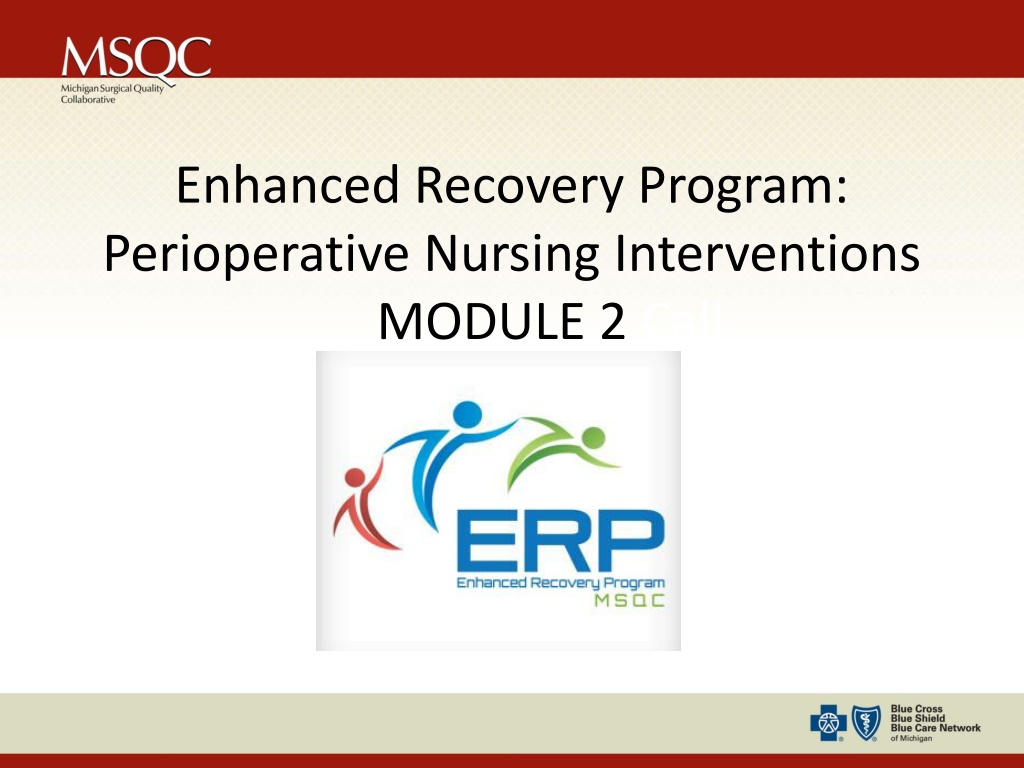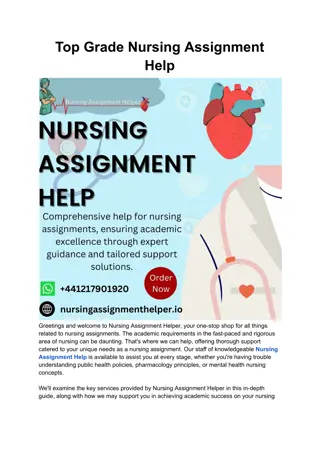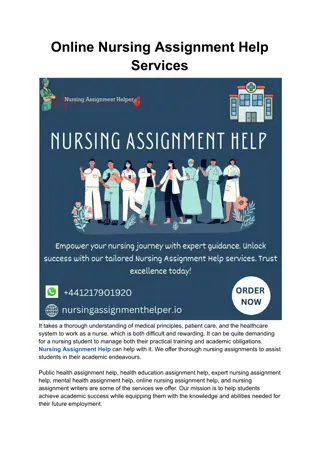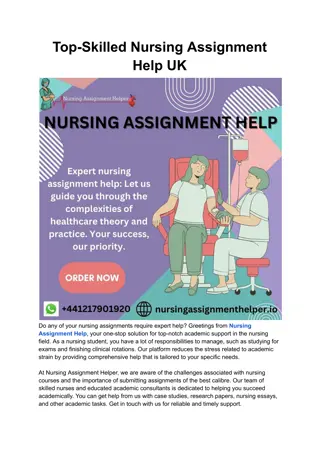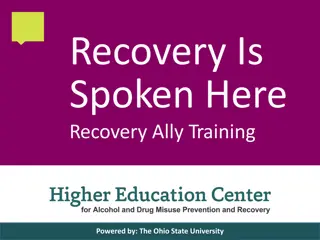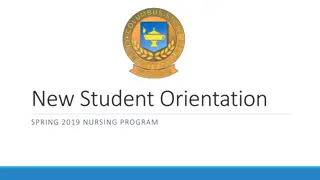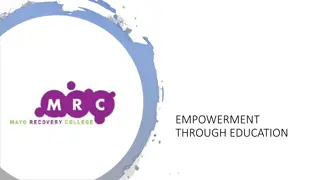Enhanced Recovery Program: Nursing Interventions and Benefits
This module focuses on the Enhanced Recovery Program in perioperative nursing, emphasizing the importance of maximizing healthcare efficiency through evidence-based practices. It highlights the benefits of ERP, including improved patient outcomes, satisfaction, and cost savings. The essentials for success involve multidisciplinary teamwork, education, and customized protocols. The role of nursing is pivotal in sustaining the ERP, contributing to better compliance, shared decision-making, and enhanced recovery goals.
Download Presentation

Please find below an Image/Link to download the presentation.
The content on the website is provided AS IS for your information and personal use only. It may not be sold, licensed, or shared on other websites without obtaining consent from the author. Download presentation by click this link. If you encounter any issues during the download, it is possible that the publisher has removed the file from their server.
E N D
Presentation Transcript
Enhanced Recovery Program: Perioperative Nursing Interventions MODULE 2 Call
Maximizing health care efficiency to improve healthcare Healthcare = system Health care = actions Evidence-based best practices Health Care Access to high- quality care Healthcare Efficiency Improved resource use
Benefits of Enhanced Recovery Program Potential impact of ERP on: Patient Outcomes Patient Experience Your Hospital (As reported by ERP Patients) Shortened length of stays(LOS) They felt better-prepared for surgery Improved efficiency on nursing workflow (due to increased patient engagement) NO increases in readmissions Their anxiety was reduced with better confidence in good outcomes Accelerated return to normal activities Improved public reporting Increased reimbursement and shared savings The surgery and hospitalization went according to plan Decreased morbidities They were ready for discharge They were likely to recommend Better Patient Outcomes Overall Cost Savings Better Patient Satisfaction
Essentials for Success Multidisciplinary Teamwork Planning Implementation through every phase Education Engagement Leadership Health care providers Development of customized ERP protocols and order sets Pre-surgical Intraoperative Post-surgical Cultivating ERP at YOUR HOSPITAL S NAME HERE Analysis ERP Compliance Outcomes Patient feedback
ERP Key Players and the Role of Nursing Core Membership (LEADERSHIP) Integral Members (MANAGERS AND STAFF)
Impact of Nursing on ERP Nurses represent the critical mass required to sustain a powerful and effective Enhanced Recovery Program Assessment Evaluation Diagnosis NURSING PROCESS 235U 236U 141Ba 92Kr Implementation Planning PATIENT RESULTS: Shared Decision Making Sustained Motivation Better Compliance with Initiatives Recovery Goals Met
Enhanced Recovery Program Elements Postoperative Phase Perioperative Phase Preoperative Phase Postoperative Interventions Intraoperative efficiency Presurgical counseling, education, conditioning, readiness and preparation. Early mobilization Metabolic/fluid conditioning Prevention of postop ileus Antiemetic prophylaxis Mechanical bowel prep with antibiotics (colectomy cases) Fluid management VTE prophylaxis Antimicrobial prophylaxis Skin prep Maintenance of normothermia BP and glucose maintenance Pain management Antiemetic prophylaxis Explanation of hospitalization Testing/ labs Nutritional assessment PONV scoring Exercise monitoring Mobilization targets Smoking cessation/ fast Alcohol cessation Fluid management Pain management Early removal of urinary catheters Early removal of wound drains Glucose control Pain management Patient feedback Outcomes reporting and analysis
ERP-Perioperative Initiatives Nursing Interventions Extended Postoperative Recovery Postoperative Recovery Preoperative Optimization Perioperative Initiatives Home Hospital Home FOCUS on Nursing responsibilities for this time span Calling all Preop, Intraop and PACU nurses
ERP and Post-Surgical Nursing Pre-Surgical Counseling and Education Post-Surgical Nursing responsibilities involve every phase of the Enhanced Recovery Program: Patient Feedback and Outcomes Reporting and Analysis Pre-Surgical Conditioning and Readiness Targeted Postoperative Interventions Pre-Surgical Intraoperative Post-Surgical Pre-Surgical Preparation Intraoperative Efficiency
ERP Nursing Responsibilities Key Components of ERP Nursing Responsibilities Contingency Planning Patient Engagement Clinical Guidelines
Postoperative Clinical Guidelines Clinical Guidelines VTE prophylaxis Control of postoperative nausea and vomiting Postoperative pain control Early postoperative (oral) feeding Early mobilization Avoidance of nasogastric tubes Avoidance of wound drainage Fluid management Urinary catheter removed postoperative day (POD) 1-2 Alvimopan Postoperative glucose control Patient feedback / outcomes analysis Multidisciplinary communication and teamwork is a key element of success
Patient Engagement the goal is toSUPPORT andSTRENGTHEN patients determinations of their health care needs and self-care efforts with a view to obtaining maximum value and improved health outcomes. Coulter (2012)
Arrival to Inpatient Floor *History Assess pre-surgical ERP compliance* VTE Prophylaxis -Mechanical (compressions stockings and intermittent pneumatic compression devices / sequential compression devices) -Pharmacological (SQ heparin / low molecular weight heparin) apply/obtain order(s) if not already complete Postoperative Nausea and Vomiting -complete PONV risk assessment in preop setting, and communicate risk to anesthesiology team. assess score and treat using multimodal approach (preop and immediate postop) -reassure patient that PONV will be closely monitored and that patient will have medications to treat it if it occurs (obtain orders if required) Pain Control -preop: reinforce education regarding non-narcotic pain control measures and benefits; inform the patient to expect some pain, but that it will be under close watch and medications will be made available to ensure that pain is controlled. -immediate postop: assess score and medicate for relief (if necessary), reinforce pain goals/targets Early Oral Feeding remind patient of early oral feeding as a goal, have patient begin chewing gum in recovery to initiate return of bowel function Alvimopan verify ordered and on patient list of scheduled medications Fluid Management INPUT:continue to record fluid type and amount received; OUTPUT: if patient left the OR with a Foley, remember the goal to d/c as soon as possible Initiate post-surgical ERP checklist
ERP Nursing Guidelines Ensure patient is receiving mechanical and (timely) pharmacological prophylaxis Assess VTE risk Educate patients regarding importance Notify physician of missed doses/refusals VTE PROPHYLAXIS Perform PONV pre-surgical risk assessment Perform regular patient assessments Communicate during hand-off, any resuce anti- emetics used for the patient in recovery Use multimodal treatment approach POSTOP NAUSEA AND VOMITING
ERP Nursing Guidelines Reinforce and educate patients regarding pain expectations and targets Perform regular pain assessments in recovery Follow multimodal approach to treatment, encouraging non-narcotic medications PAIN CONTROL Assess for compliance with carbohydrate loading and optimization of hydration in preop If the patient s case is delayed or expected to be delayed for >1 hour, notify the anesthesiology team. Preop feeding/hydration rescue measures may need to be initiated. NUTRITION
ERP Nursing Guidelines Pre-warming of patients before surgery Consider patients who may be exposed while having prolonged anesthetic procedures performed The patient s temperature should be regularly during surgery, and warming adjusted accordingly Active warming of patients should continue postoperatively MAINTENANCE OF NORMOTHERMIA Routine prophylaxis with IV antibiotics should be given 30- 60 before initiating colorectal surgery Re-dosing of antibiotics should be administered during prolonged procedures. Chlorohexidine-alcohol based skin preps are optimal for use in skin prep for surgery Hair clipping (vs. shaving) is associated with fewer surgical site infections ANTIMICROBIAL PROPHYLAXIS/SKIN PREP
ERP Nursing Guidelines Assess hydration optimization compliance preoperatively Be sure to monitor case delays and intervene accordingly (in conjunction with the anesthesia team s guidance) to avoid unnecessary fasting from fluids FLUID MANAGEMENT Nasogastric tubes and wound drains should be avoided whenever possible If necessary, assess and advocate for removal when appropriate: NG tubes inserted during surgery should be removed before reversal of anesthesia TUBES AND DRAINS
Contingency Planning Notice deviation from routine ERP course Form contingency plan with patient: Provide reassurance and education regarding options Set new targets for the patient to work toward Provide reinforcement through motivation toward new targets and encouragement of plan ** All changes should be communicated to surgeon/physician, nurse receiving patient from unit transfers, oncoming nurse at shift change and multidisciplinary team members**
Implementation Ideas Hold regular ERP team meetings where clinicians have the opportunity to discuss ERP. Review patient level data for ERP and non-ERP patients to demonstrate impact of the program. Select clinical champions from multiple areas that are excited about the program and willing to work to engage other clinicians. Acknowledge and celebrate ALL successes! http://webarchive.nationalarchives.gov.uk/*/http://institute.nhs.uk
Next, refer to the Guide for the Postoperative Phase!
Our goal is that this guide will serve as a resource to help you guide patients to achieve optimal preparation for surgery and success in realizing the many benefits of the Enhanced Recovery Program. Through monitoring, educational efforts, system changes and coordination of services of the healthcare team and many hospital divisions, patients will attain improved length of stay, decreased readmission rates and reduced morbidity and mortality, and the hospital will demonstrate a return on investment which exceeds the incremental costs of these efforts.
